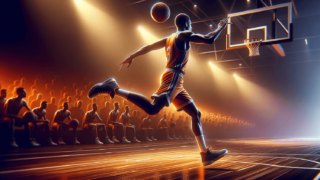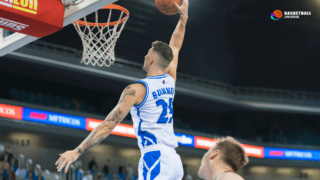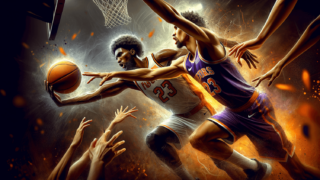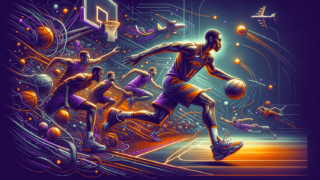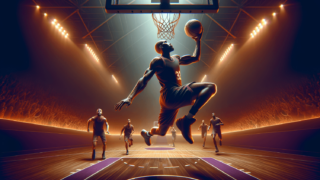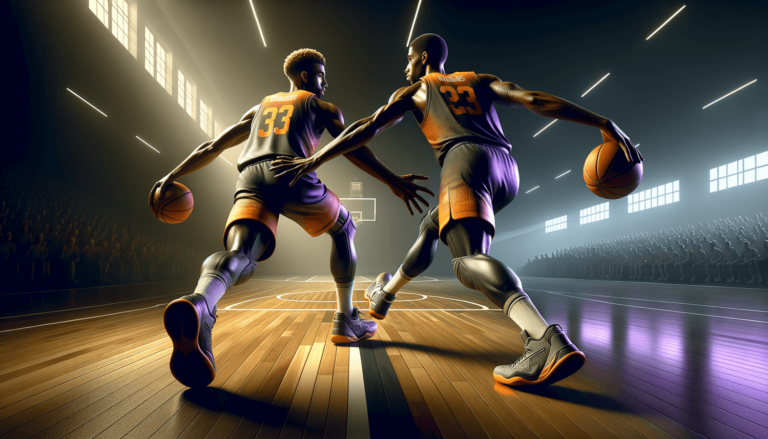
Welcome to a fascinating exploration of one of basketball’s most popular plays – the dribble handoff! As the name suggests, this maneuver combines dribbling and passing in a seamless and elegant ballet of teamwork. Whether you’re a seasoned basketball enthusiast or just getting started, prepare to enhance your understanding of the game as we dive deep into the science and art of the dribble handoff. Stay tuned for this fun and professional take on an essential element of basketball’s dynamic gameplay!
What’s a Dribble Handoff in Basketball?
A dribble handoff in basketball is a strategic play in which a player dribbling the ball hands it off directly to a teammate, usually while both players are in motion. This action allows for fluidity and deception, creating opportunities for the offense to exploit gaps or mismatches in the defense. Often used to initiate offensive sets or pick-and-roll situations, the dribble handoff has become a staple of modern basketball, providing versatility and adaptability to teams’ offensive arsenals.
The Anatomy of a Dribble Handoff
There’s more to the dribble handoff than just passing a basketball from one player to another. It’s an intricately choreographed play that involves several components, all designed to create scoring opportunities for the offense. Let’s break down each aspect of the dribble handoff to understand its importance in the game of basketball.
The Dribbler
The dribbler, usually a guard or forward, initiates the play by driving towards a teammate. Besides being able to maintain control of the ball, the dribbler must have the court vision to determine when to execute the handoff. As the dribbler moves, they must draw in defenders and create enough space for the teammate to receive the ball and make a play.
The Receiver
The receiver, often a guard or forward, is the teammate who will be accepting the handoff. It is crucial for the receiver to exhibit excellent timing, cutting towards the dribbler at an angle while maintaining their speed. Once they get the basketball, the receiver should be ready to capitalize on gaps in the defense, shoot, or create plays for teammates.
Keys to a Successful Dribble Handoff
Knowing the roles of the dribbler and receiver is essential, but there are more factors that contribute to the success of a dribble handoff. Here are a few crucial elements to consider when incorporating the play in your basketball arsenal.
Communication and Timing
Whether it’s through eye contact or verbal cues, good communication is the backbone of a successful dribble handoff. Both players must be aware of each other’s intentions to time the handoff perfectly. Good timing is important, especially when spacing is hard to come by, since it can minimize the defender’s influence on the play.
Reading the Defense
The dribble handoff’s effectiveness can be largely influenced by the positioning of the defenders. Both the dribbler and receiver must evaluate how the defense is guarding the play and adjust accordingly. For example, if the defender goes below the screen during the handoff, the receiver might pull up for a jump shot, or if the defender goes over the screen, the receiver can continue dribbling to create a driving lane.
Spacing and Court Awareness
Spacing is vital to the success of a dribble handoff. With proper court awareness, both the dribbler and receiver must ensure that they are not too close together, as this will limit their options. The dribbler should aim to provide a clear, accessible passing lane to their teammate, while the receiver should focus on exploiting open areas and creating scoring opportunities.
Benefits of Using the Dribble Handoff
So, why is the dribble handoff so popular in basketball? What makes this play such an essential part of modern offenses? Read on to discover the benefits of using the dribble handoff.
Catching the Defense Off-Guard
Defensive players can find it challenging to remain involved in the play when the dribble handoff is executed quickly and smoothly. As the dribble handoff is performed in motion, it can catch defenders off-guard and cause communication breakdowns, potentially leading to open shots or driving lanes for the offense.
Creating Mismatches
One of the main reasons teams incorporate the dribble handoff into their playbook is to create mismatches. If executed correctly, the dribble handoff can force defenders to switch, possibly creating favorable matchups for the offense. This could result in a guard being guarded by a slower defender or a big man being guarded by someone smaller, either of which could be exploited for easy points.
Setting Up Additional Offensive Options
As opponents become wary of the dribble handoff, they might begin to actively counter it. This opens up opportunities for the offense to deploy other options. For example, a well-executed fake dribble handoff can lead to open shots, quick drives, or even more complex plays as the defense scrambles to react.
Defending Against the Dribble Handoff
Opponents are always looking for ways to disrupt and neutralize the dribble handoff. What are some common defensive strategies teams use to minimize the effectiveness of this play? Let’s take a look at some key techniques.
Fighting Through Screens
One way to defend against the dribble handoff is to fight through the screens set by the offense. Defenders should maintain constant pressure on the ball handler and remain close to the receiver, reducing their chances of getting an open shot. This is especially effective against teams that rely on quick, sharp-shooting guards.
Switching
When executed correctly, switching can be an effective method to counter the dribble handoff. The defenders in charge of guarding the dribbler and receiver quickly swap defensive assignments, bypassing the screen and nullifying any mismatches. However, this strategy requires good communication and court awareness, as mismatches can still be exploited if the switch is not executed swiftly.
Trapping or Double-Teaming
Trapping or double-teaming the receiver after the handoff can be a risky but effective way to disrupt the offense. This requires quick rotations from defenders to cover open teammates, but when executed well, it can lead to turnovers and fast-break opportunities for the defense.
Final Thoughts
Understanding and mastering the dribble handoff is invaluable for players and teams looking to elevate their offensive skills in basketball. By utilizing this play effectively, you’ll create opportunities to score and catch your opponents off-guard. It takes practice and communication, but knowing when to use the dribble handoff and how to respond to defensive strategies can make all the difference in conquering the basketball court.
Popular Dribble Handoff Variations
As with many aspects of basketball, the dribble handoff can be customized and adapted to suit the needs of different teams and their offensive strategies. Here, we’ll explore some popular dribble handoff variations that coaches and players employ to gain a competitive advantage.
Screen-The-Screener Handoff
In the screen-the-screener dribble handoff, a third player (typically a big man) sets a screen for the prospective receiver, who then cuts towards the dribbler to execute the handoff. After setting the initial screen, the screener can dive towards the basket, benefiting from additional off-ball screens set by teammates after the handoff. This creates a space for a lob pass or can pull defenders away from the receivers, providing them more room to score.
Backdoor Dribble Handoff
The backdoor dribble handoff is a counter to overzealous defenders who overcommit in trying to disrupt the handoff. In this play, the receiver fakes a cut towards the dribbler before they suddenly change direction to go backdoor (i.e., towards the baseline). The dribbler then passes the ball to the receiver for an easy layup, capitalizing on the defender’s misguided anticipation.
Multiple Dribble Handoffs
Why stop at just one dribble handoff when you can execute two, three, or even more in quick succession? Multiple dribble handoffs involve a series of consecutive handoffs between different players, making it incredibly difficult for defenders to keep up or predict which player will eventually make a move towards the basket. This variation can be particularly potent when each receiver is a credible scoring threat, forcing the defense to constantly adjust and opening up scoring opportunities.
Practicing the Dribble Handoff
Now that you’re familiar with the dribble handoff, its variations, and the benefits it brings to the game of basketball, the next step is practice. Putting in the time and effort to master this play will undoubtedly elevate your team’s offensive prowess. Here are some tips for practicing the dribble handoff effectively.
Drills and Repetition
Like any other basketball skill, practice makes perfect. Incorporate dribble handoff-specific drills into your team’s training sessions to build the necessary muscle memory and develop a strong connection between the dribbler and receiver. Consider using two-ball drills, where players practice with two basketballs simultaneously, to add complexity and improve hand-eye coordination.
Game-Like Situations
Ensure that your practice sessions include real-time, game-like situations that test your team’s execution of the dribble handoff. This will prepare your players for the unpredictability and pressure of an actual game, allowing them to respond quickly and decisively when it’s time to use the handoff in a competitive setting.
Film Study
Finally, watching film of the dribble handoff, both from your own practice sessions and games, as well as those featuring professional players and teams, can be an excellent learning tool. Analyzing footage allows you to identify areas for improvement, observe subtle nuances of the play, and emulate the successful strategies employed by top basketball organizations.
Whether you’re a seasoned basketball aficionado or new to the game, understanding the nuances of the dribble handoff can elevate both your knowledge and appreciation of this exciting sport. So grab a basketball, hit the court, and start experimenting with this versatile play to see just how much it can amplify your team’s offensive potential.
Frequently Asked Questions
If you still have questions about the dribble handoff, don’t worry! We have compiled a list of some of the most common queries related to this essential basketball play. Check out these straightforward, NLP-style answers to satisfy your curiosity and help you become a true dribble handoff connoisseur.
1. What is the primary purpose of a dribble handoff?
The primary purpose of a dribble handoff is to create scoring opportunities for the offense by maintaining fluidity and deception, exploiting gaps or mismatches in the defense, or initiating offensive sets such as the pick-and-roll.
2. Who typically performs the dribble handoff?
Usually, guards or forwards execute the dribble handoff, with one player (the dribbler) driving towards a teammate (the receiver) to pass the ball to them while both players are in motion.
3. How is good communication important in a dribble handoff?
Good communication is essential in a dribble handoff, as it ensures proper timing and helps both the dribbler and receiver stay in sync. This can be achieved through eye contact, verbal cues, or other forms of non-verbal communication.
4. Why is the dribble handoff so popular in modern basketball?
The dribble handoff has become popular due to its ability to catch defenders off-guard, create mismatches, and open up additional offensive options. Its versatility and adaptability make it a valuable asset to teams’ offensive strategies.
5. What are some effective strategies for defending against the dribble handoff?
Fighting through screens, switching defenders, and trapping or double-teaming the receiver are some common defensive strategies employed to neutralize the dribble handoff and disrupt the offense.
6. How can the dribble handoff be expanded with variations?
Popular variations of the dribble handoff include the screen-the-screener handoff, backdoor dribble handoff, and multiple dribble handoffs. These variations can be customized and adapted to suit different teams’ offensive strategies and create new scoring opportunities.
7. What are key aspects to consider when practicing the dribble handoff?
When practicing the dribble handoff, focus on drills and repetition, incorporating game-like situations, and studying film to refine technique, improve timing and communication, and learn from the successes of professional players and teams.
8. How does the dribble handoff help create mismatches?
The dribble handoff can force defenders to switch assignments, potentially creating favorable matchups for the offense (e.g., a guard being guarded by a slower defender or a big man being guarded by someone smaller).
9. What are the benefits of using multiple dribble handoffs in a row?
Using multiple dribble handoffs in a row can make it difficult for defenders to keep up or predict which player will eventually make a move towards the basket, opening up scoring opportunities for various teammates.
10. How does practicing the dribble handoff with two basketballs improve hand-eye coordination?
Practicing dribble handoffs with two basketballs simultaneously can help players develop better hand-eye coordination in a more complex setting, enhancing their ability to execute smooth and effective handoffs during games.
11. How can backdoor dribble handoff counter overzealous defenders?
A backdoor dribble handoff involves the receiver faking a cut towards the dribbler before suddenly changing direction to go backdoor, which allows the offense to capitalize on the defender’s overcommitment and misguided anticipation.
12. Why is spacing crucial in a dribble handoff?
Proper spacing is critical in a dribble handoff because it ensures that the dribbler and receiver are not too close together, which would limit their options. Good spacing also allows for clear passing lanes and better opportunities to exploit open areas.
13. How can teams effectively switch on defense against a dribble handoff?
To effectively switch on defense against a dribble handoff, the defenders guarding the dribbler and receiver must quickly swap defensive assignments, bypassing the screen and nullifying mismatches. This strategy requires good communication and court awareness to minimize the risk of exploitation.
Featured Posts
- No pillar pages found.
